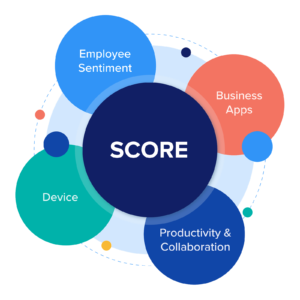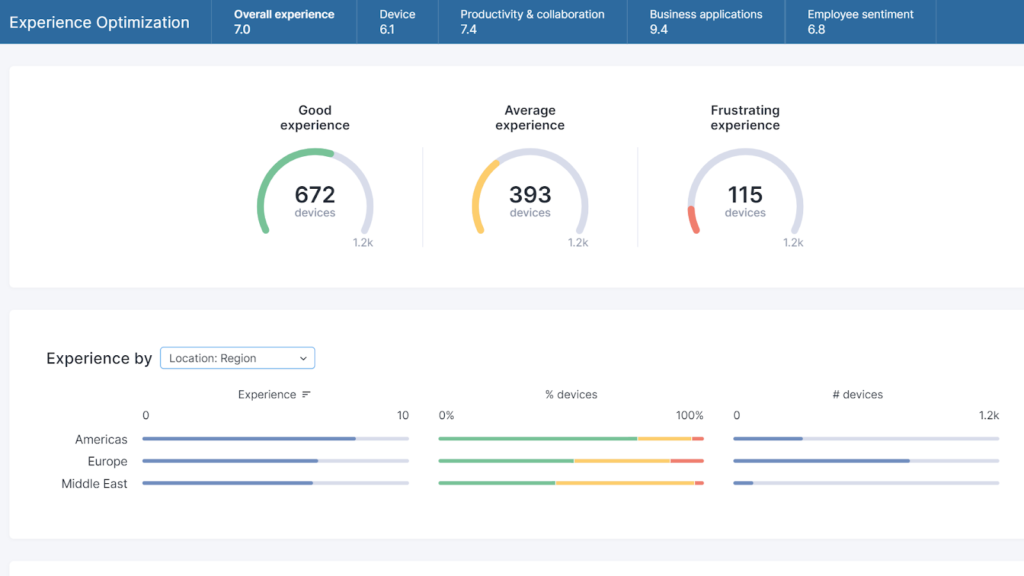Measuring Employee Experience in the Remote Work Era
<span data-mce-type="bookmark" style="display: inline-block; width: 0px; overflow: hidden; line-height: 0;" class="mce_SELRES_start"></span>
For companies of all sizes, the struggle to understand and improve digital employee experience (DEX) is nothing new. What is new, however, is the working landscape we’ve all been navigating since the pandemic—where remote work has become the norm, and where the employee experience has become almost exclusively digital.
As a result, businesses have implemented significant strategic changes over the past several months. Large companies like Facebook, Twitter, and Quora have led the charge by hiring new leadership roles exclusively focused on remote work. The number of remote jobs advertised has increased by 147% since the beginning of 2020.
Moreover, we’ve seen a massive uptick in remote solutions hitting the market, proof that remote work isn’t just a temporary “sign of the times”; rather, it’s a new industry entirely.
This recent surge in hiring and investing for remote work success is a promising development. It indicates that companies are prioritizing the tools and manpower necessary for positive customer experiences and employee experiences alike.
You in? Nexthink's Experience Conference Goes Virtual
This December Join The Brightest Minds in IT Experience Management
On the other hand, the increase in remote work investments only casts a spotlight on a common problem, one that has plagued businesses for years before COVID-19 forced them to go remote. Most businesses—even those that equip their employees with the best tools and the deepest resources—don’t know how to actually measure their employee experience.
Purchasing the best collaboration tools and hiring a Head of Remote Work is a good start, just like buying new tires for a run-down automobile is a good start—you might keep the car moving, but there are likely more complex, interior problems that need to be solved.
If you want to sustainably improve employee experience, you must first be able to measure it.
Most IT departments can’t adequately measure digital employee experience
Most business leaders are aware of the value of DEX measurement. When we recently polled technology executives in North America and EMEA, 96% of respondents agreed DEX is important. However, more than one-third of those same respondents admitted they rely on manual methods to measure DEX—and 46% don’t measure it at all!
IT teams fall short in this regard for a litany of reasons, but they typically boil down to two root problems:
- IT teams function with a reactive mindset and make improvements through trial-and-error.
- Their SLAs emphasize metrics that say little to nothing about actual employee experience.
To explain further, let’s put these problems in the context of the latest remote work-related trends:
Let’s say you’re a mid-sized company that just hired a Head of Remote Work, whose first order of business is to invest in new tools to boost remote productivity. A fancy new project management platform replaces the old one that constantly crashed and gave employees headaches. The IT team gets a more robust incident management platform that enables them to manage support tickets faster.
According to the classic IT benchmarks, these investments pay off, big time. Service availability goes up, target resolution time drops. What you don’t realize, however, is that these metrics have given you only a sliver of visibility into actual end user experience. Sure enough, you conduct an employee survey concerning service performance weeks later, and are stunned to see even more negative comments than existed prior to the new investments.
New work environment.
New technology.
Same old problem.
Remote working elevates the need for DEX measurement
The events of 2020 have only exacerbated the pitfalls of reactive IT strategies.
We saw a prime example just last month, when Slack suffered a widespread outage. Many IT teams hustled to send out instructions to employees via traditional communication channels like email or html-based surveys. What they encountered that day was a growing stack of support tickets. Productivity for many companies took a nosedive, and what might’ve been a minor inconvenience with everyone together in the office became an all-day disaster in a remote setting.
After a full day of putting out fires, most IT teams were back to square one. They might have learned some hard lessons about how to handle such an outage, but they gained no valuable insight into their employee experience. All they can do now is wait until the next outage and hope to handle it better.
But DEX hinges on much more than how quickly an IT team can tackle performance issues like last month’s Slack outage. With all the added volatility that comes with remote work, IT teams must take a full-scale mindset shift, from reacting to problems to proactively measuring, identifying and solving issues before they impact employees.
Enter: DEX scoring.

The time is now for IT teams to embrace DEX scoring
DEX scoring helps IT teams gain visibility into employee experience through actionable, quantifiable data. It’s a process that favors experience-based metrics over the traditional service-related metrics that IT teams have relied on for years.
DEX scoring combines hard metrics and employee sentiment data to provide a comprehensive view of your employees’ digital experience. By analyzing end user data related to device performance, web browsing, business apps, and other key end user information, IT teams can move on from trial-and-error tactics and towards data-driven decision making.
IT professionals at large and small companies alike have reaped the long-term rewards of DEX scoring. Hear from one of them, Arnauld Pire, Senior Manager of IT, Service Delivery and Operations at Toyota Motor Europe:
“We want to know that we’re making real improvements—reducing the number of crashes, for example—and affecting a difference to the end user’s perceptions,” says Pire. “Benchmarking our users’ IT experience helps us better understand our position and measure our progress.”

Improve your digital employee experience in 2021 and beyond
2020 has been a year of uncertainty and adversity for all businesses, but also a year of innovation and change. We’ve seen remote work become a full-fledged industry, and we’ve seen companies rise to the challenge and invest money and manpower in the remote work experience.
This year has also served as a lesson in the value of measuring employee experience. With employees dispersed across hundreds or even thousands of home offices, investing in new tools and management strategies will only get you so far.
To truly invest in your employees, invest in measuring their digital experience. Even if your remote work environment is temporary, the benefits of DEX scoring will be permanent.
If your IT department is eager to improve its work anywhere setup, and they seek tangible, proactive solutions, then contact a Nexthink representative today.
Prefer to see the Nexthink Experience platform in action?
Related posts:
- Your MS Teams Rollout Needs Specific Help—Not General Guidance
- 8 Websites Every End-User Computing Professional Needs to be Visiting Daily
- What Your IT Chatbot Can Look Like Running on Full Power
- Paul Hardy (ServiceNow): The Changing Role of IT